mParticle
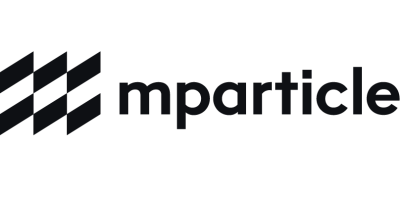
mParticle est une plateforme de données client qui permet aux clients d'intégrer facilement des données à des plateformes tierces via des intégrations de données. Avec la destination Rokt existante de mParticle, les utilisateurs peuvent intégrer sans effort des données de conversion de leur compte mParticle à Rokt, permettant un ciblage plus précis, une meilleure personnalisation et des résultats de campagne améliorés.
Ce guide décrit les étapes nécessaires pour configurer votre intégration Rokt au sein de mParticle afin d'intégrer facilement des données de conversion complètes et enrichies à Rokt pour connecter l'activité marketing, telle qu'une Référence (Referral), à des résultats qui génèrent de la valeur commerciale, tels qu'une Conversion client (par exemple, achats, abonnements ou téléchargements d'applications). Cela inclut les étapes requises pour l'authentification ainsi qu'un exemple.
Configuration de l'Intégration
Authentification
L'authentification avec la connexion Rokt Events nécessite un ID de compte et une clé API (API Key). Veuillez consulter ci-dessous comment obtenir ces identifiants :
- ID de compte : Trouvez votre ID de compte ici.
- Clé API : Travaillez avec votre gestionnaire de compte ou ingénieur solutions pour obtenir votre clé API.
Configurer une connexion de données
-
Pour commencer, vous devez vous assurer que vous avez configuré un Input. Si ce n'est pas le cas, suivez les étapes ici pour en créer un. Dans ce document, nous utiliserons WEB comme exemple. Rokt prend en charge tous les inputs mParticle tels que App, etc. Vous devez choisir tous les inputs applicables.

-
Configurer une connexion
- Sur le côté gauche, trouvez et cliquez sur Directory, et recherchez ROKT
- Cliquez sur setup
- Sélectionnez Event
- Cliquez sur Configure
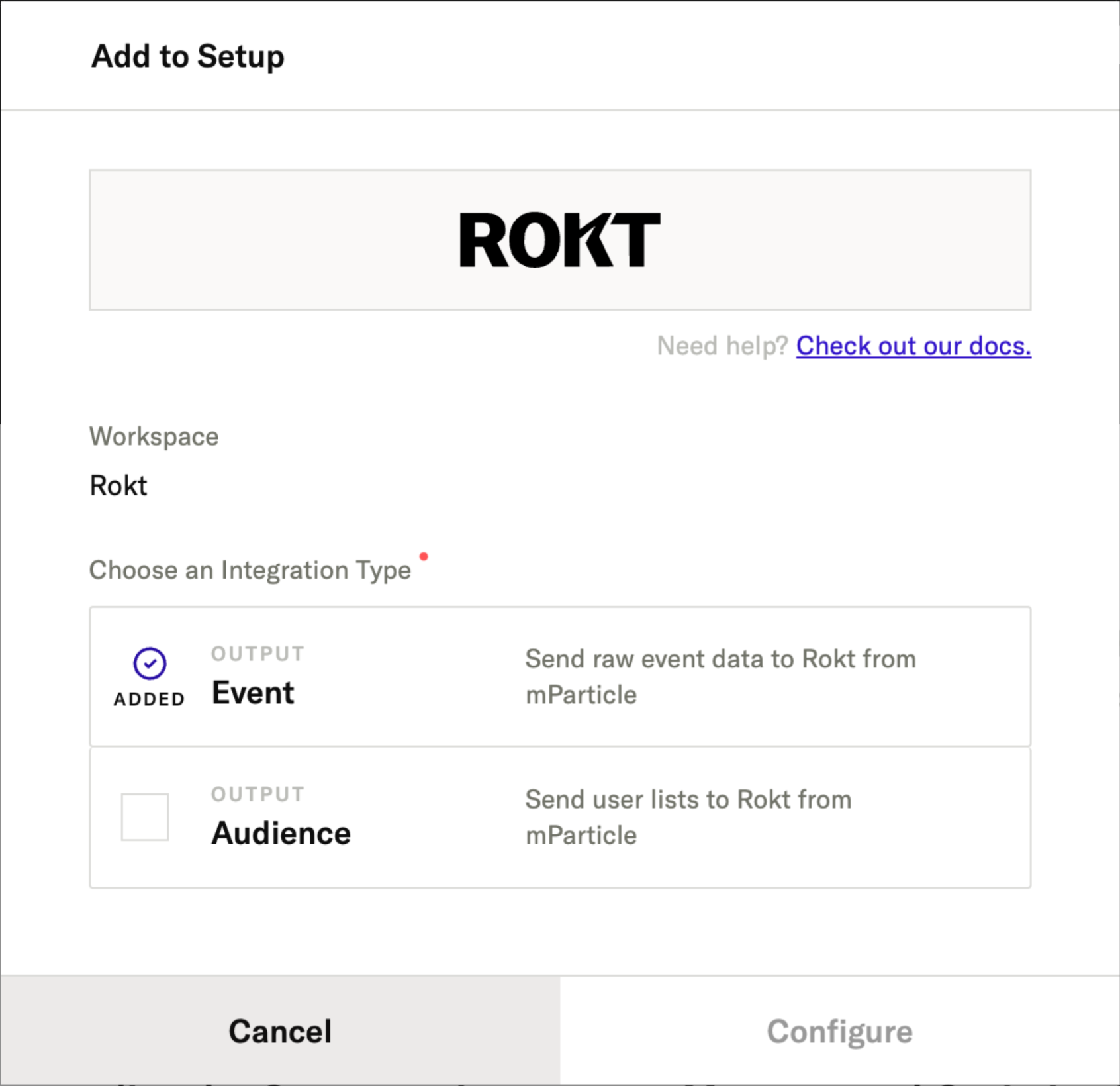
-
Remplissez votre Rokt Account ID et API Key, et cliquez sur save
-
Nommez la configuration de manière à indiquer clairement son objectif, par exemple Rokt Event Integration
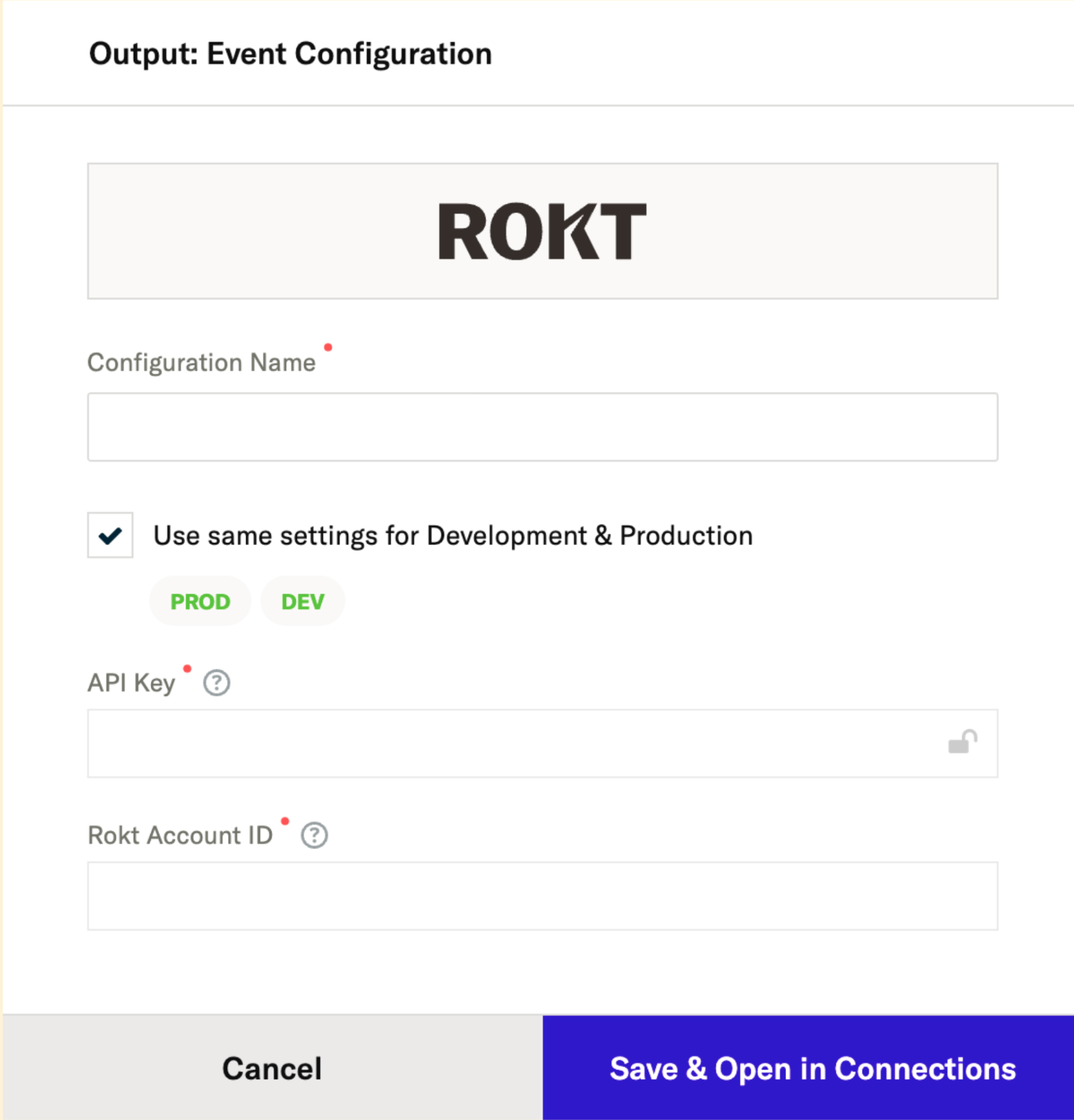
-
Cliquez sur Save & Open in Connections. mParticle devrait vous rediriger automatiquement vers la page ci-dessous. Sinon, allez à Connection > Connect. Ensuite, sélectionnez votre input de données souhaité.
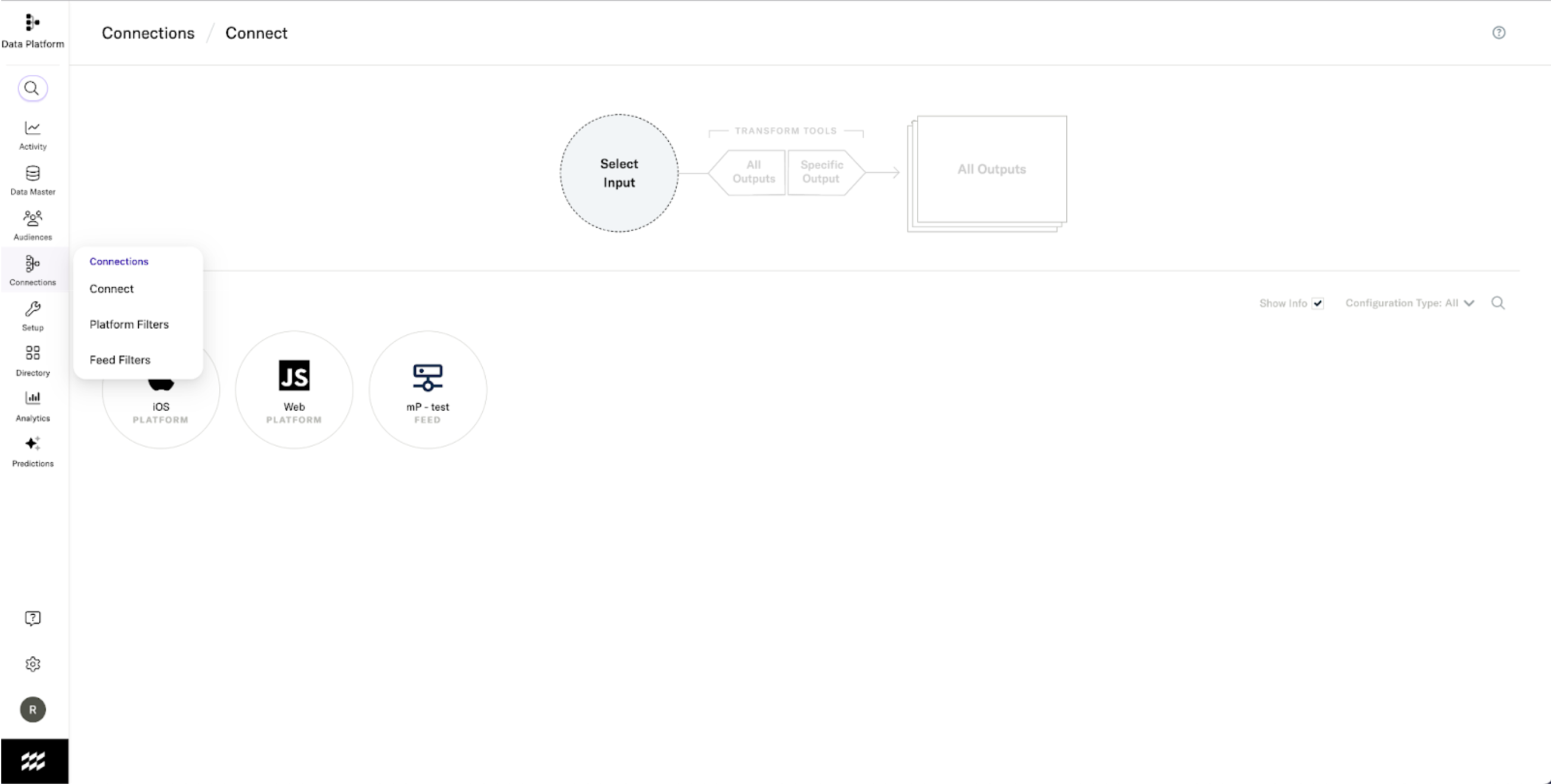
-
Sélectionnez Connect Output. Naviguez vers la configuration ROKT que vous venez de créer. Assurez-vous que l'interrupteur sous Connection Status est réglé sur activate
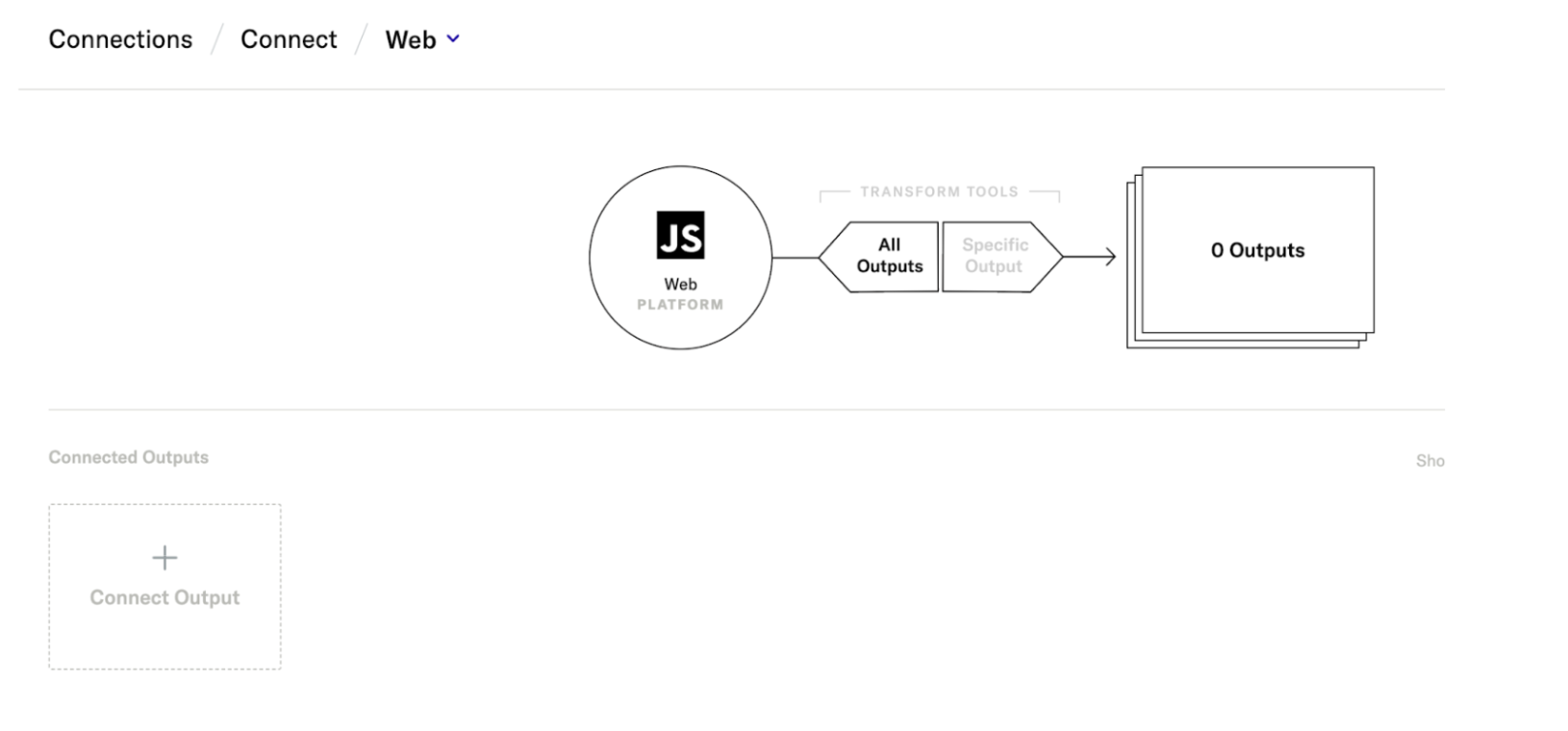
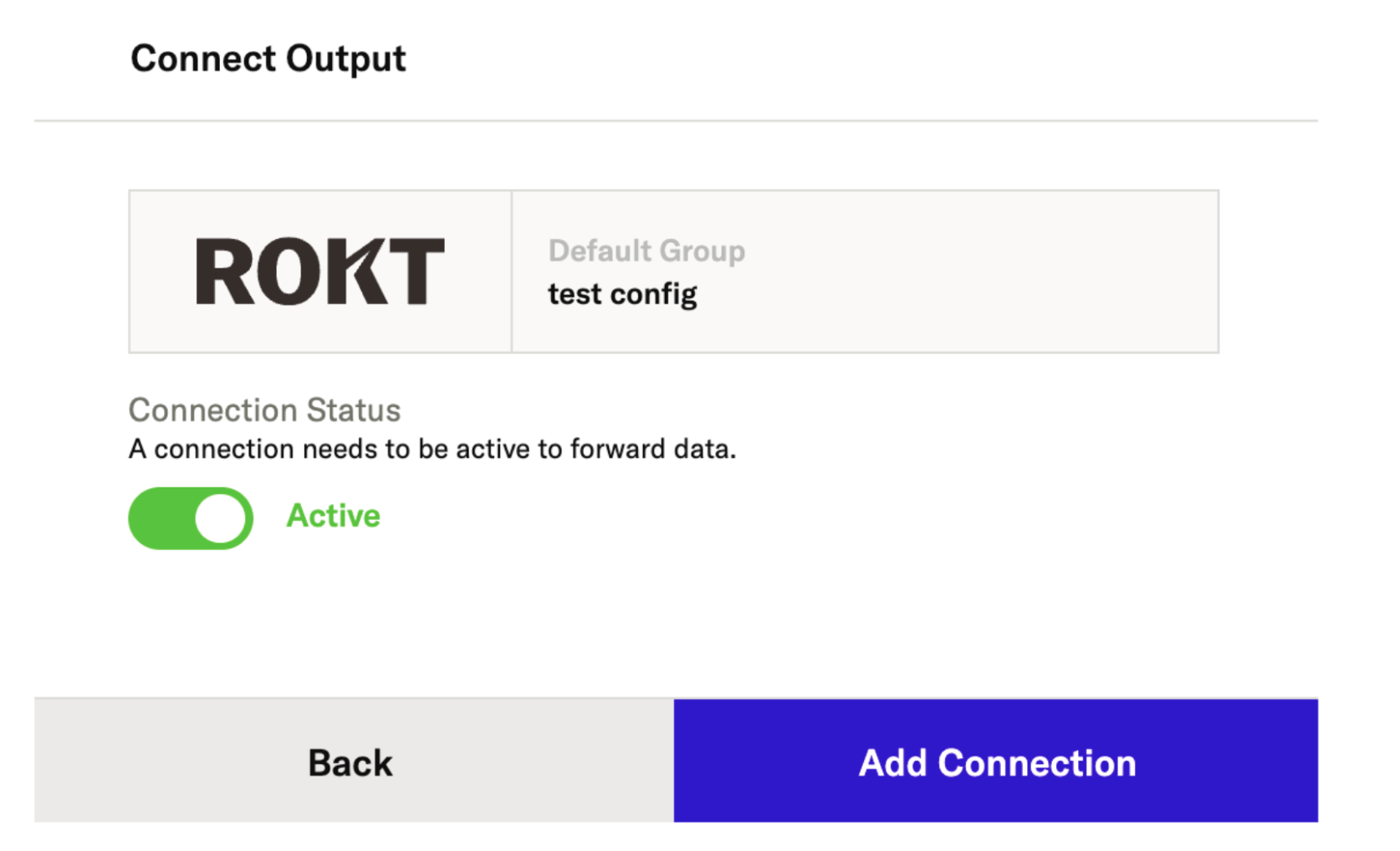
-
Cliquez sur Add Connection
-
Votre connexion est maintenant configurée ! Répétez les étapes ci-dessus pour toutes les plateformes/Inputs, par exemple Web, iOS et Android
Choisissez les Événements à Intégrer
Veuillez transmettre uniquement les types d'événements que Rokt peut utiliser pour optimiser votre campagne publicitaire.
Une fois que toutes vos Connexions sont configurées, suivez les étapes ci-dessous pour intégrer les événements souhaités à Rokt. Les événements nécessaires à l'intégration sont liés à votre campagne avec Rokt. Ce sont les événements vers lesquels Rokt optimise, c'est-à-dire purchase, free_trial, etc. Vous pouvez contacter votre Responsable de Compte si vous avez besoin de plus d'informations à ce sujet.
Allez à Connections > Filter > Platforms > Events. Ici, vous pourrez sélectionner parmi les deux options disponibles quels types d'événements seront envoyés à ROKT.
Option 1 - Événement de Commerce
Avec cette approche, vous intégrez un événement standard Product Action / Purchase à Rokt pour l'attribution. Votre page de filtre Commerce devrait ressembler à l'exemple ci-dessous :
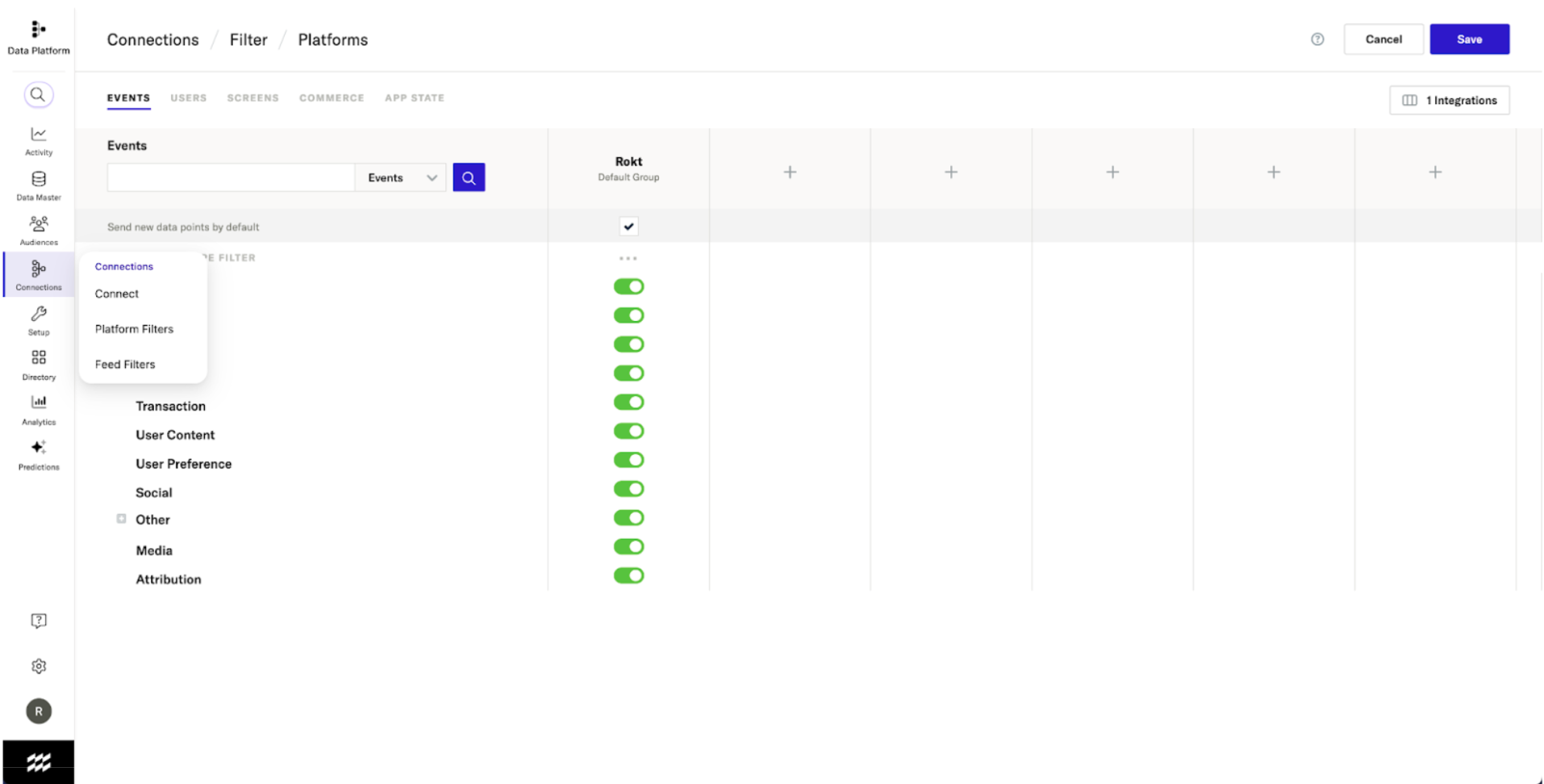
Option 2 - Événement Personnalisé
Avec cette option, vous devez intégrer un événement personnalisé nommé conversion à mParticle.
- Type d'Événement Personnalisé = other
- Nom de l'Événement Personnalisé = conversion
Votre page de filtre d'Événement Personnalisé devrait ressembler à l'exemple ci-dessous :
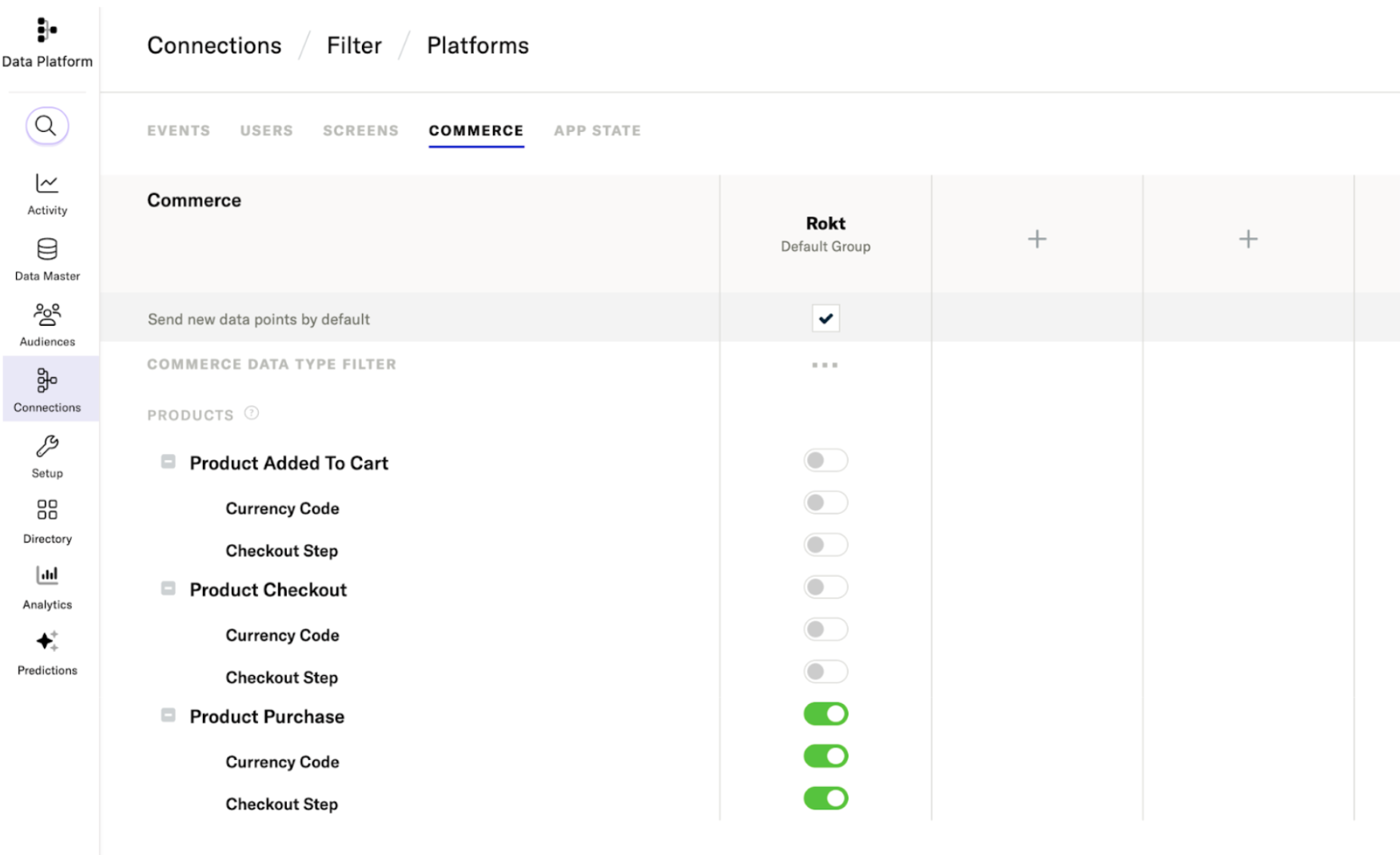
Attributs Requis
Pour boucler la boucle et attribuer les conversions à Rokt, une forme d'identification client est requise. Pour ce faire, nous recommandons :
- Utiliser les identités utilisateur standard de mParticle (pour email, mobile, etc.) ET
- Utiliser un attribut personnalisé pour RoktID
Naviguez vers l'onglet Connections > Filter > Platform > Users
Identifiants Standard
Les attributs standard mParticle suivants peuvent être utilisés pour boucler la boucle et intégrer les données de conversion avec Rokt :
- Other 1-10
Les attributs standard suivants sont pris en charge par Rokt :
| Paramètre | Description | Requis / Recommandé |
|---|---|---|
| Type d'Événement | Type d'événement ou d'action | Requis |
| ID d'Événement | Un identifiant utilisé pour identifier de manière unique un événement | Requis |
| Heure de l'Événement | Heure de l'événement en UTC | Requis |
| Email passé en texte brut, en minuscules et sans espaces de fin | Un champ email est nécessaire. Le brut est préféré mais le haché est acceptable. Le brut et le haché sont recommandés. | |
| Email (déjà haché SHA256) | Hachage SHA-256 de l'adresse email, déjà haché | Voir ci-dessus |
| Email (appliquer hachage SHA256) | Hachage SHA-256 de l'adresse email. Tealium effectuera le hachage | Voir ci-dessus |
| ID de Suivi Rokt | Un ID généré par Rokt utilisé pour faire correspondre les événements de conversion au clic d'origine | Recommandé |
| Mobile | Numéro de téléphone mobile du client convertissant | Recommandé |
| First Name | Prénom du client | Recommandé |
| Last Name | Nom de famille du client | Recommandé |
Pour une liste complète des paramètres pris en charge, consultez la documentation de l'API Event. Nous vous recommandons d'inclure des champs tels que le montant de la transaction, le code de la devise, les détails du produit et le mode de paiement pour fournir un contexte pour un meilleur ciblage et des optimisations.
Activez les attributs requis sous l'onglet Connections > Filter > Platform > Users
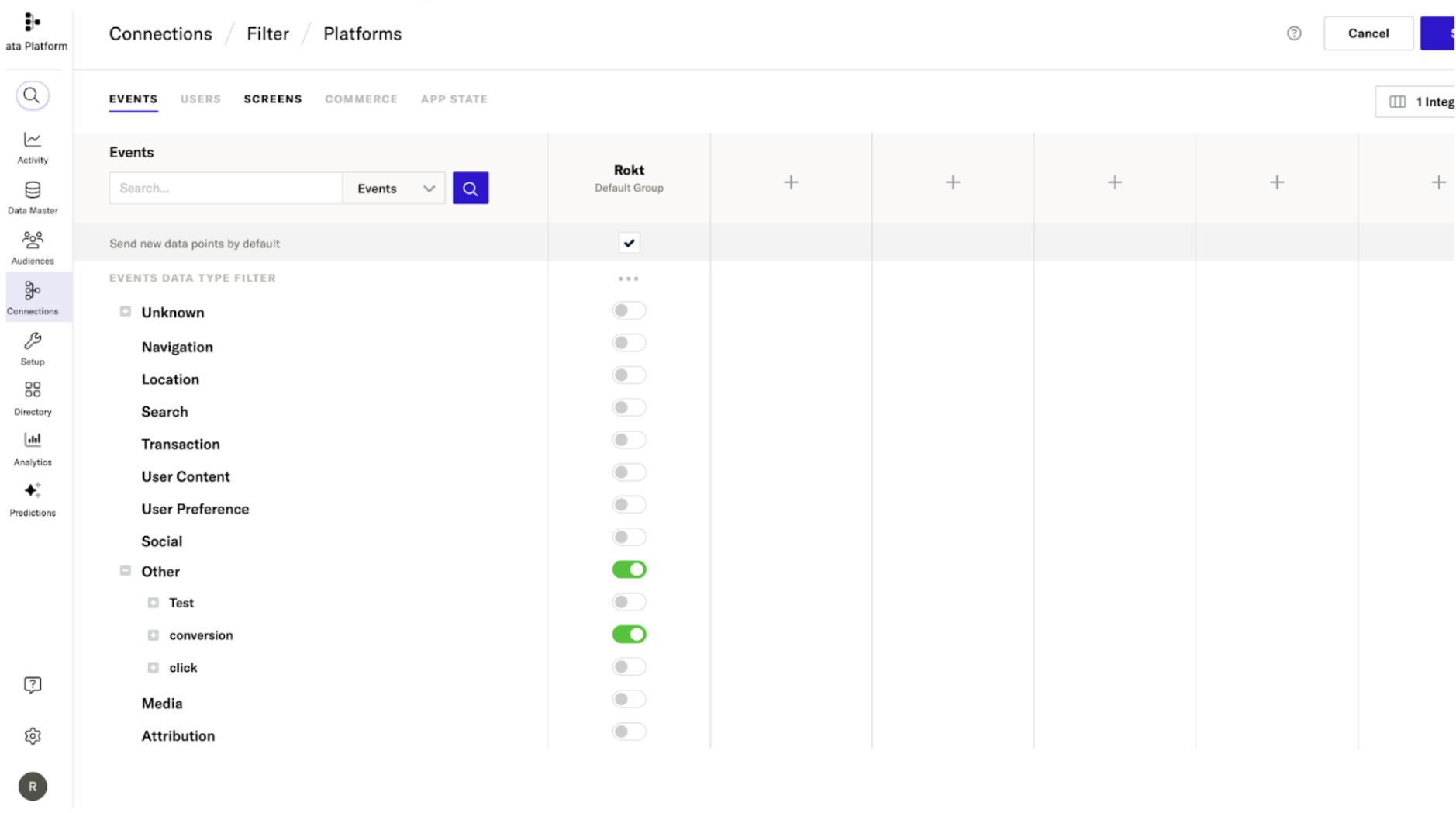
Rokt Click ID
Cette option est uniquement disponible si Rokt Click ID a été intégré avec mParticle. Rokt attribue un Rokt Click ID lorsqu'un client clique sur l'offre d'un annonceur. Le Rokt Click ID est ajouté à l'URL de la page de destination. Il appartient ensuite à l'annonceur de travailler avec mParticle pour intégrer le Rokt Click ID de l'URL de la page de destination à mParticle.
Rokt prend actuellement en charge le Rokt Click Id en tant qu'attribut de bouclage sans PII (Personally Identifiable Information). Plus d'informations sur le Rokt Click Id sont disponibles ici
Option 1 - Rokt Click Id en tant qu'Attribut Personnalisé
Pour intégrer le Rokt Click Id en tant qu'attribut personnalisé pour boucler la boucle et attribuer les conversions, suivez les instructions ci-dessous :
-
Accédez à Connections > Filter > Platforms > Events
-
Choisissez Other
-
Choisissez Conversion
-
Recherchez roktid et activez le commutateur
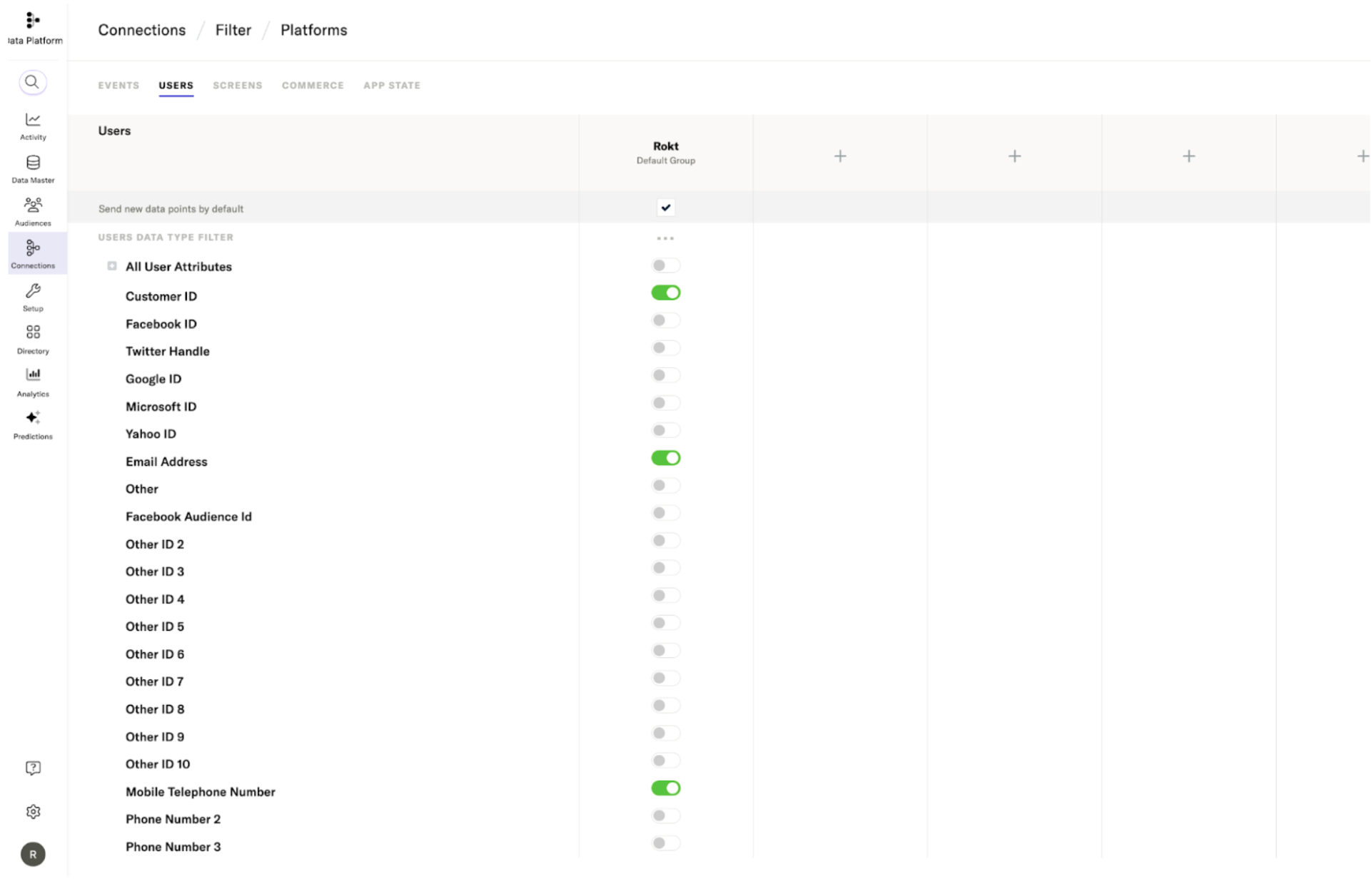
Pour que l'attribut existe, mParticle doit avoir reçu au moins un événement avec l'attribut personnalisé roktid attaché.
Option 2 - Rokt Click ID via l'identifiant standard Other
Il est également possible de mapper le Rokt Click Id à n'importe quel identifiant standard other comme dans l'exemple ci-dessous :
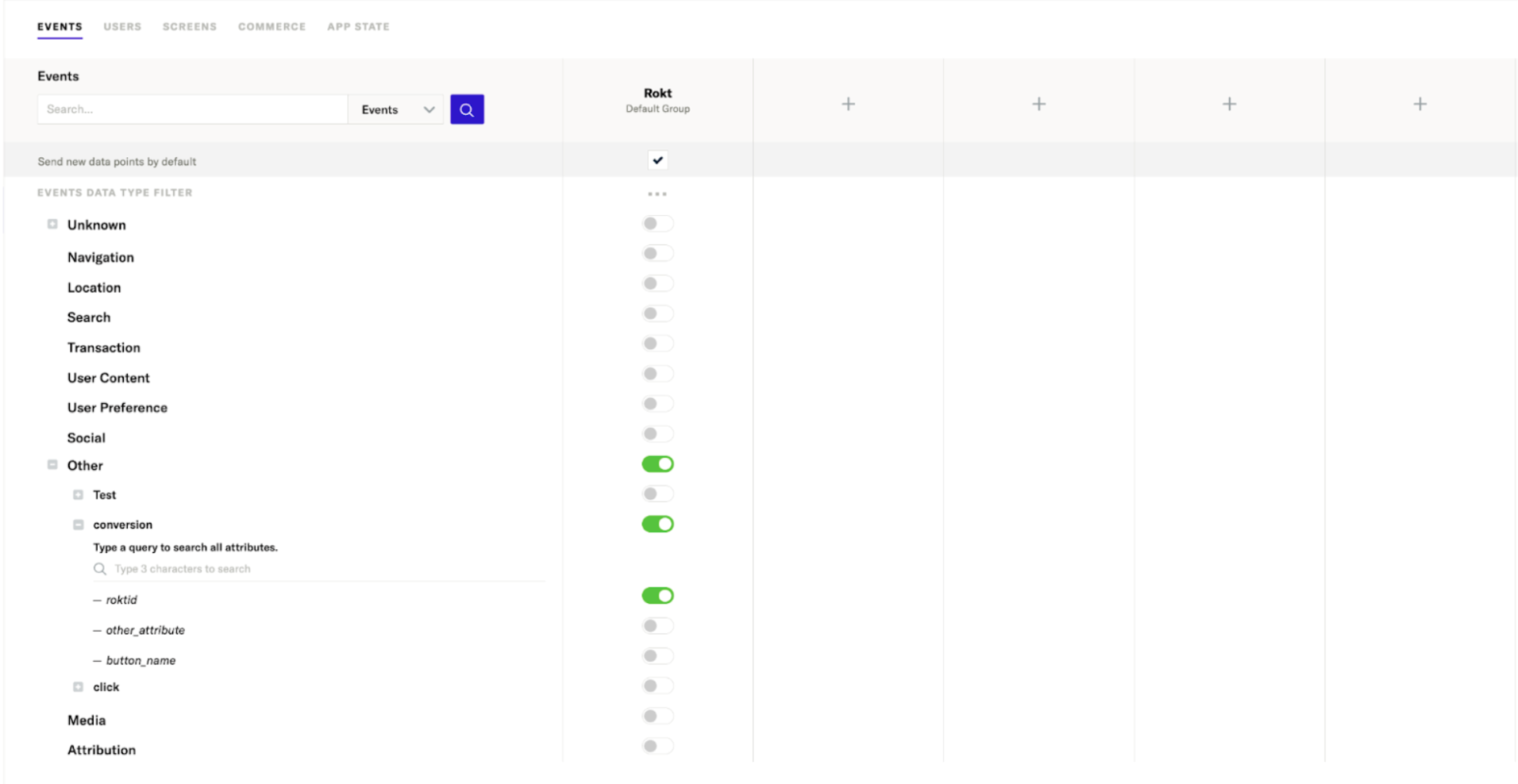
Dans ce cas, il est nécessaire de nous indiquer quels sont les attributs standard other. Les valeurs possibles incluent : other, other2, other3 jusqu'à other10